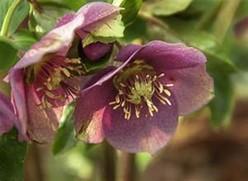Winter 2023-24
Winter wonderful hellebores!

What’s in a name?
Winter rose, Christmas rose, and Lenten rose are all common names associated with hellebores, based on their bloom season. Interestingly, hellebores are not related to the rose family but are more closely related to the Ranuculaceae or buttercup family, which also includes clematis and peonies. They are mostly native to limestone regions of southern and eastern Europe. Long-lasting flowers are available in an extraordinary range of colors from true white to delicate pinks and yellows, to deep, dark, almost black, purple. Many varieties are speckled. As the flowers age, they often fade to a soft green. Hellebores were popular with the ancient Greeks. Roman author and naturalist Pliny wrote about the use of Christmas rose as early as 1400 B.C.
Are hellebores more than just pretty faces?
These harbingers of spring are among the earliest blooming perennials, providing much needed nectar for pollinators. All parts of the plants are poisonous and repugnant to deer, gophers, and moles. The poison on the leaves, stems, flower, and sap may cause dermatitis in humans. Wear protective hand and arm coverings when handling the plants.
 A Lenten rose brings color to the late winter garden. Photo: Flickr
Planting and caring for hellebores
A Lenten rose brings color to the late winter garden. Photo: Flickr
Planting and caring for hellebores

Hellebores prefer shade or at least some sun protection and are ideal for lighting up dark, shady locations with their vibrantly colored blooms. Well-draining soil, generously amended with organic matter is essential. While plants can survive with more sun, boggy conditions will not be tolerated.
Choose your planting location carefully as, once established, hellebores do not like to be disturbed and rarely, if ever, need dividing. If the plants find themselves well situated, they may self sow. Young seedlings can be transplanted in early spring. Their bloom color may not be true to the parent.
Plants will need to be watered regularly during their first year or two in the garden to encourage a robust root system. Once established, the plants need little water.
In the late fall, feed the plants with a well-balanced organic fertilizer and add a layer of fresh mulch. Remove older or excessive foliage as the new flower buds emerge to allow the blooms to shine.
Fall is an ideal time to add new hellebores to your garden. They can also be planted in our mild winters and early spring. A pH close to neutral is preferred. Incorporate lime into your planting if your soil is extremely acid. Plants are largely pest free but be on the lookout for snails and slugs on immature plants.
 Hellebore blossoms look stunning floating in a glass bowl. Photo: Flickr
Enjoying blooms indoors
Hellebore blossoms look stunning floating in a glass bowl. Photo: Flickr
Enjoying blooms indoors

Hellebore flowers are lovely in the garden and they are also long-lasting cut flowers. Before adding them to an arrangement, dip the stem ends into boiling water for several seconds or quickly into a flame. For less work, snip their stems short and float in a bowl for up to two weeks.
Where to visit established hellebores in a garden setting
Plan a winter stroll through both the Outdoor Art Club in Mill Valley and the San Francisco Botanical Garden, where established hellebores bloom brightly. The SFBG collection is well marked and will help you decide which varieties you would like to incorporate in your garden.
Where to purchase hellebores
Many local nurseries have hellebores available. A wider variety of colors and sizes can be found online.
